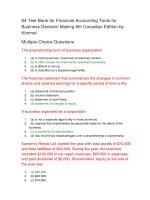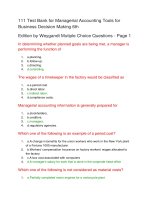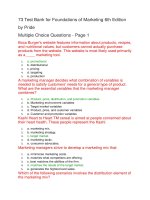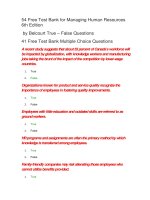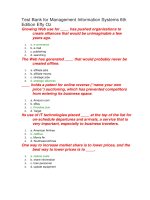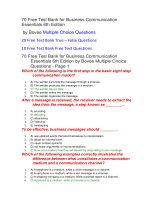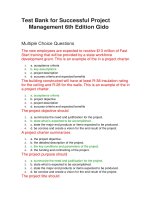168 test bank for managerial accounting tools for business decision making 6th edition
Bạn đang xem bản rút gọn của tài liệu. Xem và tải ngay bản đầy đủ của tài liệu tại đây (222.14 KB, 51 trang )
168 Test Bank for Managerial Accounting Tools for
Business Decision Making 6th Edition
True False Questions - Free Text Questions -
Mutiple Choice Questions - Page 1
Managerial accounting does not encompass
1.
a.calculating product cost.
2.
b.calculating earnings per share.
3.
c.determining cost behavior.
4.
d.profit planning.
The work of factory employees that can be physically and directly associated
with converting raw materials into finished goods is
1.
a.manufacturing overhead.
2.
b.indirect materials.
3.
c.indirect labor.
4.
d.direct labor.
Managerial accounting is also called
1.
a.management accounting.
2.
b.controlling.
3.
c.analytical accounting.
4.
d.inside reporting.
A manufacturing company reports cost of goods manufactured as a(n)
1.
a.current asset on the balance sheet.
2.
b.administrative expense on the income statement.
3.
c.component in the calculation of cost of goods sold on the income statement.
4.
d.component of the raw materials inventory on the balance sheet.
Financial statements for external users can be described as
1.
a.user-specific.
2.
b.general-purpose.
3.
c.special-purpose.
4.
d.managerial reports.
For inventoriable costs to become expenses under the matching principle,
1.
a.the product must be finished and in stock.
2.
b.the product must be expensed based on its percentage-of-completion.
3.
c.the product to which they attach must be sold.
4.
d.all accounts payable must be settled.
Product costs consist of
1.
a.direct materials and direct labor only.
2.
b.direct materials, direct labor, and manufacturing overhead.
3.
c.selling and administrative expenses.
4.
d.period costs.
The major reporting standard for presenting managerial accounting
information is
1.
a.relevance.
2.
b.generally accepted accounting principles.
3.
c.the cost principle.
4.
d.the current tax law.
Which one of the following is not a direct material?
1.
a.A tire used for a lawn mower
2.
b.Plastic used in the covered case for a home PC
3.
c.Steel used in the manufacturing of steel-radial tires
4.
d.Lubricant for a ball-bearing joint for a large crane
The managerial function of controlling
1.
a.is performed only by the controller of a company.
2.
b.is only applicable when the company sustains a loss.
3.
c.is concerned mainly with operating a manufacturing segment.
4.
d.includes performance evaluation by management.
Directing includes
1.
a.providing a framework for management to have criteria to terminate employees when
needed.
2.
b.running a department under quality control standards universally accepted.
3.
c.coordinating a company's diverse activities and human resources to produce a
smooth-running operation.
4.
d.developing a complex performance ranking system to give certain high performers
good raises.
As inventoriable costs expire, they become
1.
a.selling expenses.
2.
b.gross profit.
3.
c.cost of goods sold.
4.
d.sales revenue.
Managerial accounting information is generally prepared for
1.
a.stockholders.
2.
b.creditors.
3.
c.managers.
4.
d.regulatory agencies.
Internal reports are generally
1.
a.aggregated.
2.
b.detailed.
3.
c.regulated.
4.
d.unreliable.
Which one of the following represents a period cost?
1.
a.The VP of Sales' salary and benefits
2.
b.Overhead allocated to the manufacturing operations
3.
c.Labor costs associated with quality control
4.
d.Fringe benefits associated with factory workers
Which one of the following is not considered as material costs?
1.
a.Partially completed motor engines for a motorcycle plant
2.
b.Bolts used in manufacturing the compressor of an engine
3.
c.Rivets for the wings of a new commercial jet aircraft
4.
d.Lumber used to build tables
Manufacturing costs that cannot be classified as either direct materials or
direct labor are known as
1.
a.period costs.
2.
b.nonmanufacturing costs.
3.
c.selling and administrative expenses.
4.
d.manufacturing overhead.
For the work of factory employees to be considered as direct labor, the work
must be conveniently and
1.
a.materially associated with raw materials conversion.
2.
b.periodically associated with raw materials conversion.
3.
c.physically associated with raw materials conversion.
4.
d.promptly associated with raw materials conversion.
The reporting standard for external financial reports is
1.
a.industry-specific.
2.
b.company-specific.
3.
c.generally accepted accounting principles.
4.
d.department-specific.
Which of the following is not a manufacturing cost category?
1.
a.Cost of goods sold
2.
b.Direct materials
3.
c.Direct labor
4.
d.Manufacturing overhead
A manufacturing process requires small amounts of glue. The glue used in
the production process is classified as a(n)
1.
a.period cost.
2.
b.indirect material.
3.
c.direct material.
4.
d.miscellaneous expense.
Which one of the following is not a cost element in manufacturing a product?
1.
a.Manufacturing overhead
2.
b.Direct materials
3.
c.Office salaries
4.
d.Direct labor
Which of the following is not another name for the term manufacturing
overhead?
1.
a.Factory overhead
2.
b.Pervasive costs
3.
c.Burden
4.
d.Indirect manufacturing costs
What activities and responsibilities are not associated with management's
functions?
1.
a.Planning
2.
b.Accountability
3.
c.Controlling
4.
d.Directing
Cotter pins and lubricants used irregularly in a production process are
classified as
1.
a.miscellaneous expense.
2.
b.direct materials.
3.
c.indirect materials.
4.
d.nonmaterial materials.
Which of the following is not a separate management function?
1.
a.Planning
2.
b.Directing
3.
c.Decision-making
4.
d.Controlling
A distinguishing feature of managerial accounting is
1.
a.external users.
2.
b.general-purpose reports.
3.
c.very detailed reports.
4.
d.quarterly and annual reports.
Sales commissions are classified as
1.
a.overhead costs
2.
b.period costs.
3.
c.product costs.
4.
d.indirect labor.
The product cost that is most difficult to associate with a product is
1.
a.direct materials.
2.
b.direct labor.
3.
c.manufacturing overhead.
4.
d.advertising.
Managerial accounting is applicable to
1.
a.service entities.
2.
b.manufacturing entities.
3.
c.not-for-profit entities.
4.
d.all of these.
Managerial accounting information
1.
a.pertains to the entity as a whole and is highly aggregated.
2.
b.pertains to subunits of the entity and may be very detailed.
3.
c.is prepared only once a year.
4.
d.is constrained by the requirements of generally accepted accounting principles.
In determining whether planned goals are being met, a manager is performing
the function of
1.
a.planning.
2.
b.follow-up.
3.
c.directing.
4.
d.controlling.
Planning is a function that involves
1.
a.hiring the right people for a particular job.
2.
b.coordinating the accounting information system.
3.
c.setting goals and objectives for an entity.
4.
d.analyzing financial statements.
The wages of a timekeeper in the factory would be classified as
1.
a.a period cost.
2.
b.direct labor.
3.
c.indirect labor.
4.
d.compliance costs.
Management accountants would not
1.
a.assist in budget planning.
2.
b.prepare reports primarily for external users.
3.
c.determine cost behavior.
4.
d.be concerned with the impact of cost and volume on profits.
Which one of the following costs would not be inventoriable?
1.
a.Period costs
2.
b.Factory insurance costs
3.
c.Indirect materials
4.
d.Indirect labor costs
Both direct materials and indirect materials are
1.
a.raw materials.
2.
b.manufacturing overhead.
3.
c.merchandise inventory.
4.
d.sold directly to customers by a manufacturing company.
Because of automation, which component of product cost is declining?
1.
a.Direct labor
2.
b.Direct materials
3.
c.Manufacturing overhead
4.
d.Advertising
A manufacturing company calculates cost of goods sold as follows:
1.
a.Beginning FG inventory + cost of goods purchased – ending FG inventory.
2.
b.Ending FG inventory – cost of goods manufactured + beginning FG inventory.
3.
c.Beginning FG inventory – cost of goods manufactured – ending FG inventory.
4.
d.Beginning FG inventory + cost of goods manufactured – ending FG inventory.
Which of the following statements about internal reports is not true?
1.
a.The content of internal reports may extend beyond the double-entry accounting
system.
2.
b.Internal reports may show all amounts at market values.
3.
c.Internal reports may discuss prospective events.
4.
d.Most internal reports are summarized rather than detailed.
Which of the following are period costs?
1.
a.Raw materials
2.
b.Direct materials and direct labor
3.
c.Direct labor and manufacturing overhead
4.
d.Selling expenses
Product costs are also called
1.
a.direct costs.
2.
b.overhead costs.
3.
c.inventoriable costs.
4.
d.capitalizable costs.
Direct materials and direct labor of a company total $8,000,000. If
manufacturing overhead is $4,000,000, what is direct labor cost?
1.
a.$4,000,000
2.
b.$8,000,000
3.
c.$0
4.
d.Cannot be determined from the information provided
Manufacturing costs include
1.
a.direct materials and direct labor only.
2.
b.direct materials and manufacturing overhead only.
3.
c.direct labor and manufacturing overhead only.
4.
d.direct materials, direct labor, and manufacturing overhead.
Internal reports must be communicated
1.
a.daily.
2.
b.monthly.
3.
c.annually.
4.
d.as needed.
Which of the following is not an internal user?
1.
a.Creditor
2.
b.Department manager
3.
c.Controller
4.
d.Treasurer
Managerial accounting applies to each of the following types of businesses
except
1.
a. service firms.
2.
b. merchandising firms.
3.
c. manufacturing firms.
4.
d. Managerial accounting applies to all types of firms.
Which of the following is not classified as direct labor?
1.
a.Bottlers of beer in a brewery
2.
b.Copy machine operators at a copy shop
3.
c.Wages of supervisors
4.
d.Bakers in a bakery
As current technology changes manufacturing processes, it is likely that
direct
1.
a.labor will increase.
2.
b.labor will decrease.
3.
c.materials will increase.
4.
d.materials will decrease.
The management function that requires managers to look ahead and establish
objectives is
1.
a.controlling.
2.
b.directing.
3.
c.planning.
4.
d.constraining.
Which of the following is not a management function?
1.
a.Constraining
2.
b.Planning
3.
c.Controlling
4.
d.Directing
In an analogous sense, external user is to internal user as generally accepted
accounting principles are to
1.
a.timely.
2.
b.special-purpose.
3.
c.relevance to decision.
4.
d.SEC.
A manager that is establishing objectives is performing which management
function?
1.
a.Controlling
2.
b.Directing
3.
c.Planning
4.
d.Constraining
Which one of the following is an example of a period cost?
1.
a.A change in benefits for the union workers who work in the New York plant of a
Fortune 1000 manufacturer
2.
b.Workers' compensation insurance on factory workers' wages allocated to the factory
3.
c.A box cost associated with computers
4.
d.A manager's salary for work that is done in the corporate head office
Managerial accounting reports can be described as
1.
a.general-purpose.
2.
b.macro-reports.
3.
c.special-purpose.
4.
d.classified financial statements.
Which one of the following would not be classified as manufacturing
overhead?
1.
a.Indirect labor
2.
b.Direct materials
3.
c.Insurance on factory building
4.
d.Indirect materials
111 Free Test Bank for Managerial Accounting Tools for
Business Decision Making 6th Edition by Weygandt
Mutiple Choice Questions - Page 2
Dolan Company's accounting records reflect the following inventories: Dec.
31, 2013Dec. 31, 2012; Raw materials inventory$310,000$260,000; Work in
process inventory300,000160,000; Finished goods inventory190,000150,000.
During 2013, $600,000 of raw materials were purchased, direct labor costs
amounted to $500,000, and manufacturing overhead incurred was $480,000. If
Dolan Company's cost of goods manufactured for 2013 amounted to
$1,390,000, its cost of goods sold for the year is
1.
a.$1,500,000.
2.
b.$1,250,000.
3.
c.$1,350,000.
4.
d.$1,430,000.
Benson Inc.'s accounting records reflect the following inventories: Dec. 31,
2012Dec. 31, 2013; Raw materials inventory$ 80,000$ 64,000; Work in process
inventory104,000116,000; Finished goods inventory100,00092,000. During
2013, Benson purchased $1,060,000 of raw materials, incurred direct labor
costs of $200,000, and incurred manufacturing overhead totaling $128,000.
How much is total manufacturing costs incurred during 2013 for Benson?
1.
a.$1,392,000
2.
b.$1,404,000
3.
c.$1,388,000
4.
d.$1,400,000
Dolan Company's accounting records reflect the following inventories:Dec.
31, 2013Dec. 31, 2012; Raw materials inventory$310,000$260,000; Work in
process inventory300,000160,000; Finished goods inventory190,000150,000.
During 2013, $600,000 of raw materials were purchased, direct labor costs
amounted to $500,000, and manufacturing overhead incurred was $480,000.
The total raw materials available for use during 2013 for Dolan Company is
1.
a.$910,000.
2.
b.$460,000.
3.
c.$550,000.
4.
d.$860,000.
The subtotal, "Cost of goods manufactured" appears on
1.
a.a merchandising company's income statement.
2.
b.a manufacturing company's income statement.
3.
c.both a manufacturing and a merchandising company's income statement.
4.
d.neither a merchandising nor a manufacturing company's income statement.
Walker Company reported the following year-end information: Beginning work
in process inventory $ 46,000; Beginning raw materials inventory 24,000;
Ending work in process inventory 50,000; Ending raw materials inventory
20,000; Raw materials purchased 830,000; Direct labor 240,000; Manufacturing
overhead100,000. How much is Walker’s cost of goods manufactured for the
year?
1.
a.$834,000
2.
b.$1,174,000
3.
c.$1,170,000
4.
d.$1,178,000
What is work in process inventory generally described as?
1.
a.Costs applicable to units that have been started in production but are only partially
completed
2.
b.Costs associated with the end stage of manufacturing that are almost always
complete and ready for customers
3.
c.Costs strictly associated with direct labor
4.
d.Beginning stage production costs associated with labor costs dealing with bringing in
raw materials from the shipping docks
Kushman Combines, Inc. has $20,000 of ending finished goods inventory as
of December 31, 2013. If beginning finished goods inventory was $10,000 and
cost of goods sold was $50,000, how much would Kushman report for cost of
goods manufactured?
1.
a.$70,000
2.
b.$10,000
3.
c.$60,000
4.
d.$40,000
Cost of goods sold
1.
a.only appears on merchandising companies' income statements.
2.
b.only appears on manufacturing companies' income statements.
3.
c.appears on both manufacturing and merchandising companies' income statements.
4.
d.is calculated exactly the same for merchandising and manufacturing companies.
Ogleby Inc.'s accounting records reflect the following inventories: Dec. 31,
2012Dec. 31, 2013; Raw materials inventory$120,000$ 96,000; Work in process
inventory156,000 174,000Finished goods inventory150,000 138,000. During
2013, Ogleby purchased $840,000 of raw materials, incurred direct labor costs
of $150,000, and incurred manufacturing overhead totaling $192,000. How
much is total manufacturing costs incurred during 2013 for Ogleby?
1.
a.$1,188,000
2.
b.$1,206,000
3.
c.$1,182,000
4.
d.$1,200,000
Benson Inc.'s accounting records reflect the following inventories: Dec. 31,
2012Dec. 31, 2013; Raw materials inventory$ 80,000$ 64,000; Work in process
inventory 104,000 116,000; Finished goods inventory100,000 92,000. During
2013, Benson purchased $1,160,000 of raw materials, incurred direct labor
costs of $200,000, and incurred manufacturing overhead totaling $128,000.
Assume Benson’s cost of goods manufactured for 2013 amounted to
$1,360,000. How much would it report as cost of goods sold for the year
1.
a.$1,368,000
2.
b.$1,400,000
3.
c.$1,460,000
4.
d.$1,352,000
Laflin Company reported the following year-end information: Beginning work
in process inventory $1,080,000; Beginning raw materials inventory300,000;
Ending work in process inventory900,000; Ending raw materials
inventory480,000; Raw materials purchased960,000; Direct labor800,000;
Manufacturing overhead720,000. Laflin Company's cost of goods
manufactured for the year is
1.
a.$2,300,000.
2.
b.$2,480,000.
3.
c.$2,120,000.
4.
d.$2,660,000.
Cost of goods manufactured in a manufacturing company is analogous to
1.
a.ending inventory in a merchandising company.
2.
b.beginning inventory in a merchandising company.
3.
c.cost of goods available for sale in a merchandising company.
4.
d.cost of goods purchased in a merchandising company.
If the amount of "Cost of goods manufactured" during a period exceeds the
amount of "Total manufacturing costs" for the period, then
1.
a.ending work in process inventory is greater than or equal to the amount of the
beginning work in process inventory.
2.
b.ending work in process is greater than the amount of the beginning work in process
inventory.
3.
c.ending work in process is equal to the cost of goods manufactured.
4.
d.ending work in process is less than the amount of the beginning work in process
inventory.
Dolan Company's accounting records reflect the following inventories: Dec.
31, 2013Dec. 31, 2012; Raw materials inventory$310,000$260,000; Work in
process inventory300,000160,000; Finished goods inventory190,000150,000.
During 2013, $600,000 of raw materials were purchased, direct labor costs
amounted to $500,000, and manufacturing overhead incurred was $480,000.
Dolan Company's total manufacturing costs incurred in 2013 amounted to
1.
a.$1,530,000.
2.
b.$1,490,000.
3.
c.$1,390,000.
4.
d.$1,580,000.
On the costs of goods manufactured schedule, depreciation on factory
equipment
1.
a.is not listed because it is included with Depreciation Expense on the income
statement.
2.
b.appears in the manufacturing overhead section.
3.
c.is not listed because it is not a product cost.
4.
d.is not an inventoriable cost.
Cost of goods manufactured is calculated as follows:
1.
a.Beginning WIP + direct materials used + direct labor + manufacturing overhead +
ending WIP.
2.
b.Direct materials used + direct labor + manufacturing overhead – beginning WIP +
ending WIP.
3.
c.Beginning WIP + direct materials used + direct labor + manufacturing overhead –
ending WIP.
4.
d.Direct materials used + direct labor + manufacturing overhead – ending WIP –
beginning WIP.
Worth Company reported the following year-end information: beginning work
in process inventory, $180,000; cost of goods manufactured, $816,000;
beginning finished goods inventory, $252,000; ending work in process
inventory, $220,000; and ending finished goods inventory, $264,000. Worth
Company's cost of goods sold for the year is
1.
a.$804,000.
2.
b.$828,000.
3.
c.$776,000.
4.
d.$552,000.
On the costs of goods manufactured schedule, the item raw materials
inventory (ending) appears as a(n)
1.
a.addition to raw materials purchases.
2.
b.addition to raw materials available for use.
3.
c.subtraction from raw materials available for use.
4.
d.subtraction from raw materials purchases.
Benson Inc.'s accounting records reflect the following inventories: Dec. 31,
2012Dec. 31, 2013; Raw materials inventory$ 80,000$ 64,000; Work in process
inventory104,000116,000; Finished goods inventory100,00092,000. During
2013, Benson purchased $1,160,000 of raw materials, incurred direct labor
costs of $200,000, and incurred manufacturing overhead totaling $128,000.
How much raw materials were transferred to production during 2013 for
Benson?
1.
a.$1,392,000
2.
b.$1,176,000
3.
c.$1,160,000
4.
d.$1,144,000
111 Free Test Bank for Managerial Accounting Tools for
Business Decision Making 6th Edition by Weygandt
Mutiple Choice Questions - Page 3
If the total manufacturing costs are greater than the cost of goods
manufactured, which of the following is correct?
1.
a.Work in Process Inventory has increased.
2.
b.Finished Goods Inventory has increased.
3.
c.Work in Process Inventory has decreased.
4.
d.Finished Goods Inventory has decreased.
The inventory accounts that show the cost of completed goods on hand and
the costs applicable to production that is only partially completed are,
respectively
1.
a.Work in Process Inventory and Raw Materials Inventory.
2.
b.Finished Goods Inventory and Raw Materials Inventory.
3.
c.Finished Goods Inventory and Work in Process Inventory.
4.
d.Raw Materials Inventory and Work in Process Inventory.
For a manufacturing firm, cost of goods available for sale is computed by
adding the beginning finished goods inventory to
1.
a.cost of goods purchased.
2.
b.cost of goods manufactured.
3.
c.net purchases.
4.
d.total manufacturing costs.
Using the following information, compute the cost of direct materials
used.Raw materials inventory, January 1 $30,000; Raw materials inventory,
December 31 60,000; Work in process, January 1 27,000; Work in process,
December 31 18,000; Finished goods, January 1 60,000; Finished goods,
December 31 48,000; Raw materials purchases 1,500,000; Direct labor 690,000;
Factory utilities 225,000; Indirect labor 75,000; Factory depreciation 500,000;
Operating expenses 630,000
1.
a.$1,590,000.
2.
b.$1,530,000.
3.
c.$1,500,000.
4.
d.$1,470,000.
